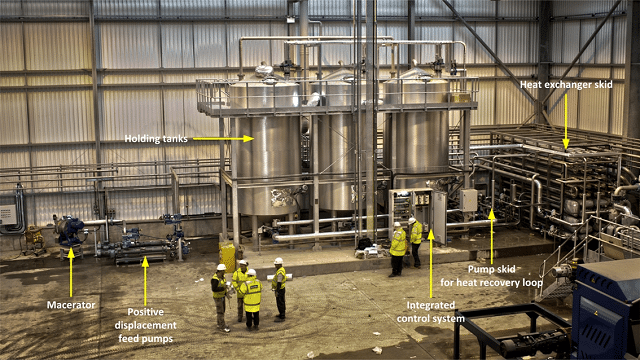Heat: The Forgotten Element of Farm AD

Anaerobic digestion (AD) produces many valuable and useful products, including biogas (which can then be turned into heat, electricity or biomethane gas) and digestate, a biofertilizer rich in nutrients and organic matter. However, many AD plants also produce incidental heat, which can be captured and used within the AD process or for other on-site operations.
Wasted heat is becoming increasingly important, not only from an economic point of view, put also politically. In the UK the Renewable Heat Incentive is the key policy driver to encourage the utilization of heat from renewable sources, including incidental heat from the AD process, while some European countries now specify targets for the use of heat from AD plants.
Sources of heat
Surplus heat produced by biogas combustion in a combined heat and power (CHP) unit is the most common heat source within an AD plant. Other processes which result in residual, usable heat include:
- Digestate pre-heating
- Digester heating (especially in summer when less heating is required)
- Pasteurization (either before or after digestion)
- Electricity generation (e.g. via CHP)
- Biogas upgrading to biomethane (heat is required for the process, but up to 75% of it can be recaptured and reused)
- Digestate concentration
A minimum temperature of 158°F may be required for pasteurization, leaving 86-104°F of ‘left over’ heat, which has historically been wasted to the atmosphere. This heat could instead be put to good use elsewhere within the AD process. Equally, heat left over from concentrating digestate could be used within pasteurization.
What is a heat exchanger?
Heat exchangers take heat from one process or place and transfer it to another. In practice, they allow the heat from a liquid or gas pass to another liquid or gas without the two having to come into direct contact. Common everyday examples include domestic radiators (which transfer heat from a boiler to a room) and car radiators (which take heat away from the engine).
Two of the most common types are Plate Heat Exchangers and Tubular Heat Exchangers. However, within these broad categories, there are many different models and refinements and it is important to understand what is being offered. It’s therefore, advisable to consult a specialist who can explain the benefits of different types and perhaps offer different solutions. For example, HRS corrugated tube heat exchangers are designed so that the constant swirling of the fluid in the tube prevents sediment and clogging when used with certain materials like digestate.
Whichever system is proposed, it is important to compare running costs, including maintenance and cleaning, over the full life of the plant – downtime caused by regular dismantling or cleaning can quickly eat into any capital savings made at the time of purchase.
Potential uses for heat in the AD process
So, having identified a source of heat, what can be done with it? There are a number of options with the AD process, including: preheating feedstock; for pasteurising; to reduce the volume of digestate or even to upgrade biogas to biomethane, for use as a transport fuel or for injection into the gas grid.
Other uses for heat
There are many uses of heat on farms, from space heating of greenhouses and polytunnels to drying crops or biomass fuels. Many livestock buildings require heat, particularly for pig and poultry production, and where farms have diversified to create office or business centers there is often the scope to install district heating systems.
With careful planning and a long term approach which considers the full life of an AD plant – not just initial purchase prices – the individual heat loads of each process within an AD operation can be greatly reduced by using recaptured heat, resulting in improvements in both efficiency and product quality.
To gain a greater understanding of the AD Process, please review our HRS AD Process Infographic.